Application of the Momentum Equation
In this section we will consider the following examples:
- Force due to the flow of fluid round a pipe bend.
- Force on a nozzle at the outlet of a pipe.
- Impact of a jet on a plane surface.
1. The force due the flow around a pipe bend
Consider a pipe bend with a constant cross section lying in the horizontal
plane and turning through an angle of
 . .

Flow round a pipe bend of constant cross-section
Why do we want to know the forces here? Because the fluid changes direction,
a force (very large in the case of water supply pipes,) will act in the bend. If
the bend is not fixed it will move and eventually break at the joints. We need
to know how much force a support (thrust block) must withstand.
Step in Analysis:
- Draw a control volume
- Decide on co-ordinate axis system
- Calculate the total force
- Calculate the pressure force
- Calculate the body force
- Calculate the resultant force
1 Control Volume
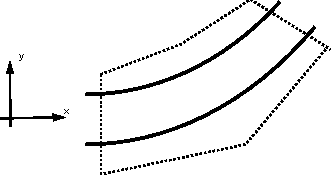
The control volume is draw in the above figure, with faces at the inlet and
outlet of the bend and encompassing the pipe walls.
2 Co-ordinate axis system
It is convenient to choose the co-ordinate axis so that one is pointing in
the direction of the inlet velocity. In the above figure the x-axis points in
the direction of the inlet velocity.
3 Calculate the total force
In the x-direction:
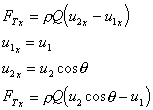
In the y-direction:
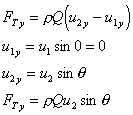
4 Calculate the pressure force

5 Calculate the body force
There are no body forces in the x or y directions. The only body force is
that exerted by gravity (which acts into the paper in this example - a direction
we do not need to consider).
6 Calculate the resultant force


And the resultant force on the fluid is given by
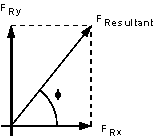

And the direction of application is

the force on the bend is the same magnitude but in the opposite
direction

2. Force on a pipe nozzle
Force on the nozzle at the outlet of a pipe. Because the fluid is contracted
at the nozzle forces are induced in the nozzle. Anything holding the nozzle
(e.g. a fireman) must be strong enough to withstand these forces.
The analysis takes the same procedure as above:
- Draw a control volume
- Decide on co-ordinate axis system
- Calculate the total force
- Calculate the pressure force
- Calculate the body force
- Calculate the resultant force
1 & 2 Control volume and Co-ordinate axis are shown in the figure below.

Notice how this is a one dimensional system which greatly simplifies matters.
3 Calculate the total force

By continuity,
 , so , so

4 Calculate the pressure force

We use the Bernoulli equation to calculate the pressure

Is friction losses are neglected,

the nozzle is horizontal,

and the pressure outside is atmospheric, , ,
and with continuity gives

5 Calculate the body force
The only body force is the weight due to gravity in the y-direction - but we
need not consider this as the only forces we are considering are in the
x-direction.
6 Calculate the resultant force


So the fireman must be able to resist the force of

3. Impact of a Jet on a Plane
We will first consider a jet hitting a flat plate (a plane) at an angle of
90, as shown in the figure below.
We want to find the reaction force of the plate i.e. the force the plate will
have to apply to stay in the same position.
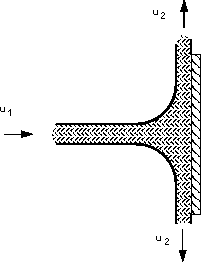
A perpendicular jet hitting a plane.
The analysis take the same procedure as above:
- Draw a control volume
- Decide on co-ordinate axis system
- Calculate the total force
- Calculate the pressure force
- Calculate the body force
- Calculate the resultant force
1 & 2 Control volume and Co-ordinate axis are shown in the figure below.
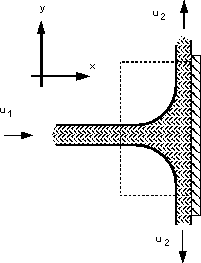
3 Calculate the total force

As the system is symmetrical the forces in the y-direction cancel i.e.

4 Calculate the pressure force.
The pressure force is zero as the pressure at both the inlet and the outlets
to the control volume are atmospheric.
5 Calculate the body force
As the control volume is small we can ignore the body force due to the weight
of gravity.
6 Calculate the resultant force

Exerted on the fluid.
The force on the plane is the same magnitude but in the opposite
direction

|

